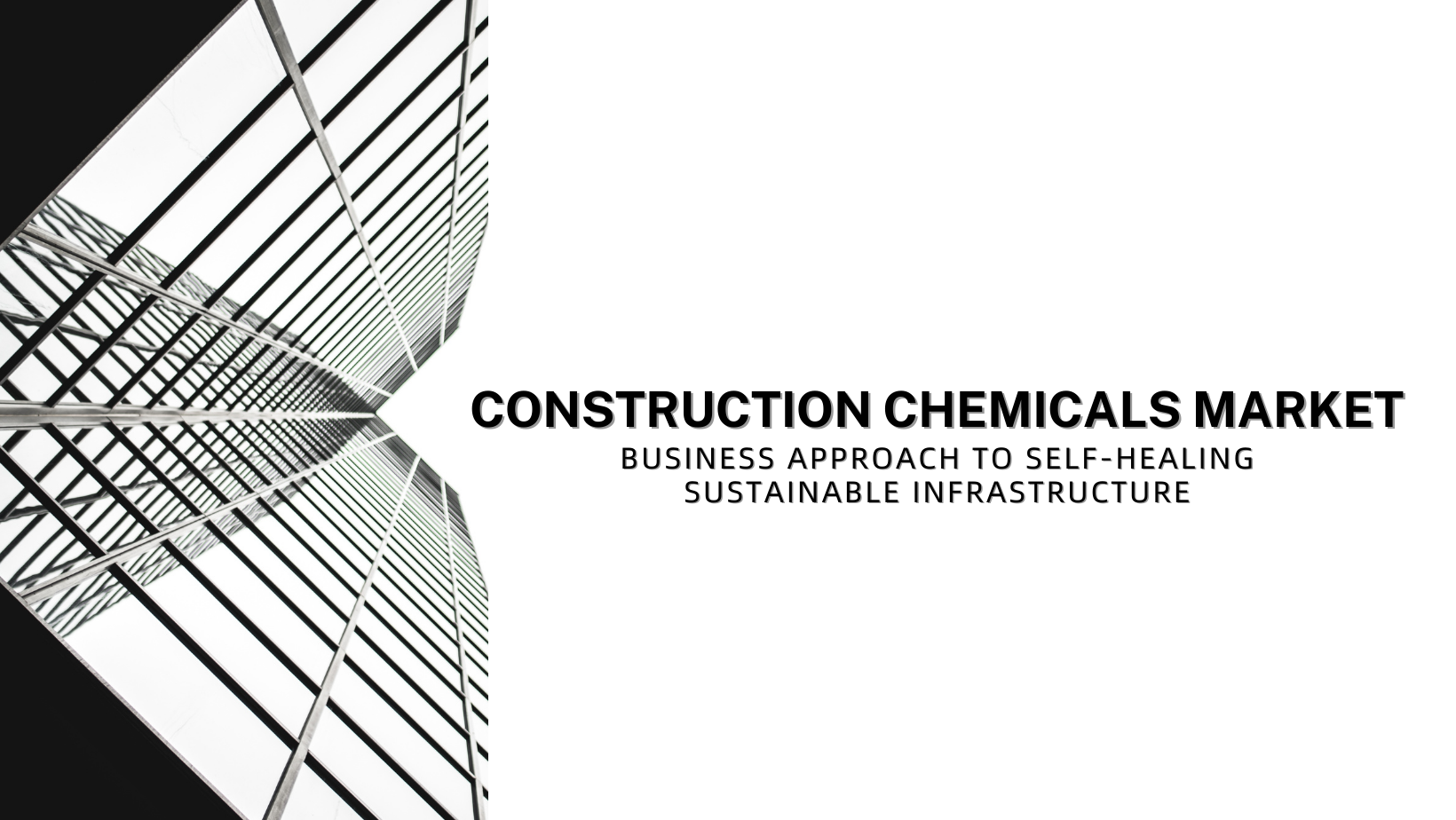United Nations in 2015, adopted the Sustainable Development Goals for 2030. These are significant initiatives towards socio-economic development. Reflected through the adoption of 169 unique targets. SDGs have provided new lenses for construction sector companies. Construction chemicals market players are striving to translate their desires into sustainable solutions. The construction industry plays a crucial role in the economic growth of nations. It also directly uplifts the quality of life through necessary facilities.
Construction companies face three-dimensional pressure from economics, climate duty, and social equity. As a consequence of stringent regulations, companies are bound to invest and develop new sustainable alternatives. The construction sector is complex and schedule-driven. This industry has always attracted chronic problems such as cost overruns and waste generation. Traditional designs only focus on cost and performance. Sustainable construction goes beyond these parameters. It also considered resource minimization.
The construction chemicals market was valued at USD 50,952.86 million in 2022, this market is anticipated to surpass the valuation of USD 71,449.75 million by 2028. The market is estimated to grow with a CAGR of 5.8% from 2022 to 2028.
Modern construction admixtures are revolutionizing the industry by boosting its workability. Superplasticizers and self-consolidating concrete are here to mark a new tide of transformation in the construction sector. One of the most ground-breaking developments in construction chemicals is self-healing materials. These materials repair themselves to increase the shelf life of the building.
Construction Chemical Market – Trends
Green Building Materials Foreseen to Gain Lucrative Market Share
Griming the peak of climate change has raised pressure on construction chemical companies. They are pushed to adopt sustainable variants and initiate recycling waste. This awareness appears to be escalating pushing companies to innovations such as green building materials. The nature of green buildings refers to the use of efficient materials without compromising on structural integrity.
Precast concrete aids in modest, efficient construction. Buildings made with this concrete tend to survive all weather conditions. They provide a long shelf life. This concrete is desired for the mass construction of pedestrian ramps, dressing room areas, and concession stands.
Beams, railroad tiles, and decks made of precast concrete are foreseen to gain more demand in the coming years. This material can reduce the cost of construction. These are made of locally available raw materials hence they reduce the cost of transport. The recycling process is involved in the formation of precast concrete. It makes it sustainable and addresses its impact on the environment.
Recycled Materials – Reframing Trend in Construction Chemicals Market
Recycled glass use is driven by environmental concerns, resource conservation, and waste reduction motives. Recycled glass finds ways through various materials such as glass-fiber reinforced concrete, and terrazzo flooring showcasing the versatility of its nature. This reduces the demand for new raw materials. In the construction sector, recycled glass is used to produce eco-friendly building materials and urban streetscapes. This is suitable for making counterparts, insulation, and tiles. In art and decor, these glasses are used to generate unique looks for interiors.
Recycled metal plays a crucial role in the reduction of environmental impact. Construction sector companies are leaning toward recycled metals. Recycled materials are used in reinforcing concrete structures. Recycled steel is often used in durable structures such as beams. Aluminum and copper are also used in construction due to their modern finish and cost-potency. Companies in the UK focus on sourcing scrap materials from local recyclers. Working with local companies can help construction chemical companies to create a strong supply chain.
Antimicrobial Coatings for Mitigation of Molds
Buildings face a high threat from the growth of molds leading to their premature degradation. High moisture places such as bathrooms and kitchens can develop mold that weakens structural integrity. The incorporation of antimicrobial coatings can protect against the growth of bacteria. Hence, the antimicrobial coatings market attracting significant growth in the recent past. This novel niche is estimated to bring high sales for companies in the coming years. The antimicrobial coatings market is estimated to cross a valuation of USD 7,514.56 million by the end of 2028.
Eco-friendly Flooring- A Profitable Niche for Market Players
Fast-paced infrastructure projects are anticipated to bring more demand for flooring companies in the coming years. Functionality and looks are equally focused on by flooring companies while designing flooring. Laminate and ceramic tile varieties are attracting substantial investment from manufacturers. Producers focus research on material properties. This improves the strength of materials.
Eco-friendly flooring is a new niche for companies. Ecologically harvested sources mark green decor trendy in both commercial and residential spaces. Terrazzo flooring has gained traction of attention across the globe due to its purpose. These are formed using small chips of marble and granite. This novel segment is foreseen to bring traction of growth in the flooring market. These eco-friendly flooring can be innovated through the use of plastic bags. Recycled plastic is used in making sustainable carpets.
Multifaceted Benefits for Construction Chemical Market Players
- Business Reputation
Endurance is the driver of growth in construction companies that provide sustainable construction chemicals. Switching to sustainable practices often attracts more customers to brands and opens new spaces. Companies adopting durable products tend to pass compliance parameters to avoid legal issues.
- Reduced Environmental Impact
It’s the right time for construction chemical market players to initiate moves to reduce environmental impact. Reducing emissions and waste can save costs for companies. Durable chemicals contribute to energy efficiency and companies can meet green standards.
- Eco-friendly Brand Differentiators
Companies offering eco-friendly alternatives going to create a brand difference. They are likely to capture a major market share due to the demand for green building materials. Chemicals having longer lifespans and resilience to climate change are foreseen to reduce frequent replacement. This enhances the value proposition for market players.
- Supply Chain Risk Mitigation
Companies while embracing endurance should also position themselves in risk management. Market players should be prepared for supply chain disruptions. Companies responsive to changing consumer demand are likely to stay ahead of the competition.
Construction Chemicals Market is Expanding, but Where is the Growth?
Adhesives and sealants assist in the bonding of structures and create airtight and watertight sealants are hugely in demand in growing construction sites. Coats and paints enhance aesthetic looks while offering protection against UV radiation and chemical abrasion. These segments are expected to grow in the coming years due to rising emphasis on aesthetics.
The industry is producing eco-friendly chemicals to reduce carbon footprint. Nanomaterials are foreseen to gain traction of attention in the construction sector owing to their properties such as strength, and self-healing properties.
Construction Chemical additives are used in the escalation of concrete 3D printing expected to transform the construction sector. These construction chemicals are estimated to notice lucrative demand in insulation, addressing energy consumption in buildings.
A growing population is bound to bring skyrocketing growth in construction. Construction chemicals crafting commercial spaces, safe homes, and public infrastructure. ‘Energy efficiency’ is likely to unfold novel prospects in construction chemicals. The construction chemistry accommodates more materials. The introduction of transparent wood and carbon fiber is estimated to bring a new tide of conversion. Self-healing concrete, and aerogel are some lucrative potential segments.
Major growth is estimated from developing regions. In developing nations, urbanization is a driving factor for construction projects. Manufacturers need global supply chains. There will be ample space in developing regions.
Asia Pacific markets account for major construction chemicals market share valued at USD 18,800 million in 2022. Countries such as China, India Japan, and South Korea are foreseen to remain leading markets for construction chemicals.
Rising investment from the government in public infrastructure is driving the growth of this market. Foreign investments in these nations are likely to attract growth in market share. Technology and material research in these regions are about to bring a swift uptake in the market. Public Private Partnership (PPP) models are responsibly driving construction chemicals market growth.
North America is estimated to gain a significant market share in construction chemicals. This market is estimated to surpass a valuation of USD 19,000 million in 2028. Observed by the US Census Bureau, government spending on building construction chemicals has increased by 10% than in 2021. This has opened space for producers to grow. Europe is also foreseen to remain a key market for construction sector companies.
Construction Chemicals Market – Future Outlook
The future of construction chemical market looks promising due to widespread innovation in green construction. High-tech advancements such as Nanoparticles are estimated to bring a tide of change in this industry. More Biophilic buildings will emerge in the future to meet the balance of development and endurance. Producers have a key role in making future buildings safer and durable.
Certainly, there are more environmental incentives pushing businesses to unlock new ways to increase their ROI. Major companies already focusing on green and sustainable alternatives in construction chemicals. Green admixtures and cool roof treatments are essential for the long shelf life of the building. These functional additions can impact positively global residential and commercial construction sector growth.



